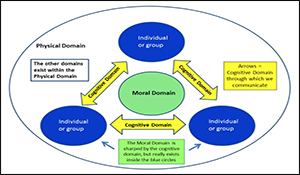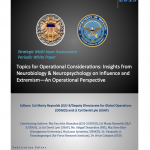Neuro-Psychology/Biology of Influence & Extremism

Insights from Neurobiology & Neuropsychology on Influence and Extremism—An Operational Perspective.
Author | Editor: Reynolds, M. (JS/J-3/DDGO) & Lyle, D. (USAF).
This report provides the operational and policy communities with a deeper understanding of the unique behavioral and neurobiological factors that underlie political extremism enhanced by interaction in the cyber realm. It addresses the implications of advances in neurobiology and neuropsychology for the way we plan and execute military operations as part of a comprehensive approach to counter violent extremists and the spread of their violent political narratives. The paper focuses on the intersection of emerging cyber technologies and human biology including of both psychological and neurobiological dimensions of behavior. For the purposes of this white paper, we will refer to these two dimensions as cyberpsychology and cyberneurobiology respectively.
Key Insights
- Modern information technology is empowering violent extremist organizations (VEOs) by providing cheap and anonymous forums to target large audiences. Advances in Cyber- Based Communication Technology (CBCT) will revolutionize how the DOD operates in cyberspace and will heighten challenges to Military Information Support Operations or MISO (formerly psychological operations or PSYOP).
- The next twenty years will see a paradigm shift in the fundamental character of the Internet that will revolutionize how people interact globally. Changes include
- the shift from Internet Protocol version four (IPv4) to Internet Protocol version six (IPv6) and the emergence of the Next Generation Internet;
- alternative Domain Name Systems;
- generic top-level and internationalized domain names;
- Broadband mobility;
- Cloud computing and big data;
- Ubiquitous computing; and
- IPTV (a technology that allows for broadcast of audio-video material).
- Bottom line: The impending changes will add additional challenges to the ability of MISO and cyber operations to influence perceptions.
- Communication technologies are means, not ends—they shape social worlds by connecting people in distinct ways, but it is the social world itself that creates outcomes.
- Deemphasizing the distinction between mass media and social media facilitates more fruitful exploration of the social implications of different means of communication.
- A four-way communication typology (i.e., speed, directionality, span, and configuration) allows exploration of the human terrain.
- CBCT can blur the lines between physical reality and cyber-formed reality, which may differ in delivering catalysts for extremist action while potentially removing vital inhibitors.
- CBCT likely does not contribute to radicalization and mobilization to political extremism in a linear fashion. Rather, the various modes of CBCT interact with shaping factors (i.e., culture, values, genetic background, access to technology, etc…) and transition factors (i.e., activators, catalysts, inhibitors, and interventions) to produce psychological and behavioral outcomes.
- Only a very small subset of individuals becomes more radical in their thinking or mobilizes due to interactions with CBCT.
- The impact of CBCT on a person is dependent on the individual’s motivation for using the medium.
- Bottom line: CBCT often provides isolated individuals the informational equivalent of an echo chamber through which they can actively or passively access information that is consistently biased toward already expressed preferences and, thus, reinforces and strengthens their existing worldviews and limits the probability of their encountering information that is potentially contradictory or disconfirming. Tailored search algorithms and the psychologically rewarding behavior of participating in “echo-chambers” accentuate these tendencies.
- Complex systems concepts provide theoretical frameworks and insights important to designing tailored counter violent extremist organizations (VEO) intervention strategies.
- Neurobiological underpinnings, processes of socialization, and the constantly changing modern information environment help illuminate the causes for the bottom up emergence of VEOs. In so doing, they help suggest operational approaches to defeat them.
- Socialization has always required communication. The rapid expansion in digital media dramatically increases the ways that social groups can form, organize, and plan for action.
- Connectedness in the modern information environment tends to reinforce, not replace, basic human needs to connect with others in person.
- Real complex systems do not resemble static structures to be collapsed; they are usually much closer to flexible, constantly respun spider webs.
- Countering strategies should focus on the interaction of the physical, mental, and moral domains instead of physically focused, relatively static center of gravity concepts.
- Without an understanding of how all three domains relate to one another dynamically, one may miss the right points of leverage and combinations of interventions that will produce the greatest synergetic effect to influence the direction and momentum of constantly evolving social systems.
- Bottom line: A strategy based on a solid understanding of the dynamic linkages between all three social domains (physical, cognitive, and moral), coupled with solid comprehension of complexity concepts like bottom up emergence, is more likely to help us choose the right combinations of interventions to successfully derail radicalization before violent ideas become violent acts and before violence becomes part of the unquestionable core identity of the individual and the group.
- Emerging research in cyberpsychology and cyberneurobiology can be integrated with existing PSYOP/MISO processes to create both a set of individualized influence tactics and guide their implementation.
- Synthesizing traditional methods with recent advances in neuroscience, cyberpsychology, and captology (the study of persuasive technology) can produce an advanced set of personalized persuasion tactics. This would allow PSYOP/MISO planners to rely on firmly established linkages between perception and actions when developing both their intelligence requirements and the desired psychological effects.
- Research in cyberpsychology and cyberneurobiology should produce empirically informed processes designed to target underlying neural mechanisms to create specific psychological effects on a target.
- Countering VEOs must address target audiences at the macro (population) and micro (individual) levels.
- Bottom line: Appending existing processes to include experimental findings in cyberpsychology and cyberneurobiology along with technological advances from captology will allow the U.S. to combat radicalization across domains with greater precision. Currently, however, there is insufficient empirical data to support explicit linkages between triggers and specific behaviors, and thus experimental validation is necessary.
Selected Chapters:
- Cyber on the Brain: The Effects of Cyberneurobiology & Cyberpsychology on Political Extremism (A. Desjardins)
Contributing Authors
Maj Gen John Shanahan (JS/J-3/DDGO), Col Marty Reynolds (JS/J-3/DDGO), Lt Col David Lyle (USAF), Ms. Abigail Desjardins (NSI), Maj Dave Blair (Georgetown University), Maj Jason Spitaletta (USMCR), Dr. Panayotis A. Yannakogeorgos (Air Force Research Institute), Dr. Hriar Cabayan (OSD

Comments